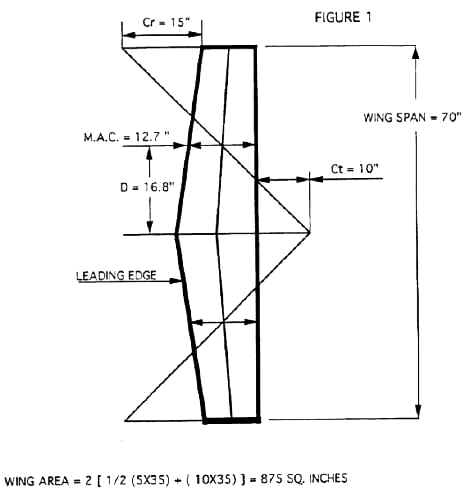| There are two ways I
know to find the M.A.C. The first is mathmatical, the second is graphic. The graphic
method has the advantage of not only determining the M.A.C., but also indicates its location on the wing. If you have a straight rectangular wing,
the M.A.C. is the actual wing chord. Let’s go over the mathmatical method first. To use the following
formula, you need to know only two things: the wing’s chord at the root (Cr) and the
tip (Ct). Plug these numbers into the formula below. Using the example of a wing with a 15" root chord (Cr) and a tip chord (Ct) of 10", the formula cranks out a M.A.C. of 12.7". This is very close to being the average chord of the wing. Now. let’s take a look at a graphic method. If you have either full size or scale drawing of your wing, the hard part is already done as the first step is to make a scale drawing of "your" wing. Figure 1 is a scale computer drawing of the wing in the above example. On your drawing, draw two lines; the first extends forward (perpendicular to the wing span) from the leading edge at the tip and it’s length is equal to the length of the root chord (Cr) on your drawing. Next, draw a line extending back (again perpendicular to the wingspan) from the trailing edge at the root that is as long as the tip chord (Cr) on your drawing.
Actually, you can reverse the direction of these lines and the results will be the same but one must go forward and the other back. From the forward end of the line at the tip, draw a line that connects to the aft end of the line at the root. This line will cut diagonally across the wing. The next step is to draw a line that connects the midpoint of the root chord (Cr) to the midpoint of the tip chord (Ct). The location of the M.A.C. is at the intersection of the lines drawn in these two steps. The length of the M.A.C. is the chord of the wing at that point. Measure your scale or full size drawing. Now, that we know what the M.A.C. is,
we can determine the T.M.A.: At this point, we now know the M.A.C.
(12.7") and the T.M.A. (33"). Now, we need to know the areas of the wing and the
horizonal stabilizer. For non-rectangular surfaces, the easiest way to calculate the area
is to divide the wing into rectangles and triangles. The area of a triangle is equal to
1/2 the length times the width. For example, the wing area is 875 sq." (SW) and the
horizontal stab area (SH) is 165 sq.". |
